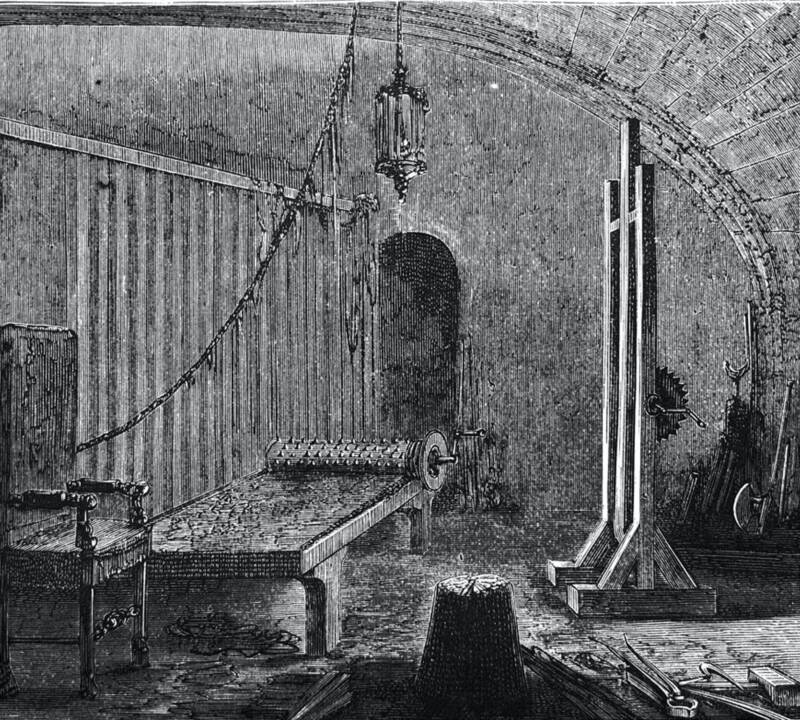Though it was an innocuous-looking wooden frame, the torture rack might have been the medieval era's most brutal device — and it was used well into the 17th century.
Originally believed to have been used in antiquity, rack torture is most often associated with medieval times. At a time when executioners meted out creative — albeit cruel — forms of punishment, this particular device stood in a class all its own.
Consisting of a wooden frame on which a victim was laid with their arms and legs bound to a roller on either end, the device was used to stretch out victims until their muscles popped or were rendered useless.
But contrary to popular belief, rack torture wasn’t left behind in the 1400s. Indeed, various forms of it popped up in different countries across the world — and were reportedly used in Britain well into the 17th century.

Wellcome ImagesRack torture devices like this would leave victims brutalized — and oftentimes, paralyzed.
How The Rack Torture Device Worked
Comprised of a rectangular frame raised ever-so-slightly from the ground, the rack torture device looked like a bed — on the surface. But a closer look revealed a much more sinister composition.
The rack had a roller on either end, to which the victim’s wrists and ankles were chained. Once strapped in, the victim’s body was stretched beyond comprehension, often at a snail’s pace, to put increased pressure on the shoulders, arms, legs, back, and hips.
Ultimately, the executioner could choose to stretch the limbs until the joints began to pop, and eventually permanently dislocated. Muscles, too, were stretched to the point of ineffectiveness.
The device also served as a restraint so that victims could be subjected to a variety of other pains, as well. From getting their nails pulled out to getting burned with hot candles, and even having spikes dug into their spine, victims who were unfortunate enough to suffer rack torture would often be lucky to come out with their lives.
And the rare few who did were left unable to move their arms or legs for the rest of their lives.
Origins And Famous Uses Of The Sinister Tool
Historians believe that the tool’s most primitive form originated in ancient Greece. Herostratus, an arsonist who gained infamy in the fourth century B.C.E. for setting fire to the second Temple of Artemis, was infamously tortured to death on the rack.

Getty ImagesA depiction of the torture chamber in Ratisbon, Bavaria, features a rack device on the bottom left. From Harper’s Magazine. 1872.
Historians also noted that ancient Greeks likely used the rack to torture people they had enslaved as well as non-Greeks. The ancient Roman historian Tacitus also recounted a story where the emperor Nero used the rack on a woman named Epicharis in a vain attempt to get information from her. Nero’s attempts were unsuccessful, however, as Epicharis preferred to strangle herself than give up any information.
The arrival of the rack torture device as modern historians know it was introduced by John Holland, the second Duke of Exeter, in 1420. The Duke, who was the constable of the Tower of London, famously used it to torture women, thus earning the device the nickname, “The Duke of Exeter’s daughter.”
The Duke infamously used the device on the Protestant Saint Anne Askew and the Catholic martyr Nicholas Owen. Askew was reportedly so stretched out that she had to be carried to her execution. Even Guy Fawkes — of the infamous Fifth of November Gunpowder Plot — was also said to be a victim of rack torture.
But among the most famous alleged victims of this device was William Wallace, the Scottish rebel who inspired Mel Gibson’s Braveheart. Indeed, Wallace met a particularly gruesome end, as after being stretched, he was publicly emasculated, his genitals burned in front of him, and disemboweled before a crowd.
The rack was most notoriously used by the Spanish Inquisition, a Catholic organization that forced everyone in Europe and its territories to convert to Catholicism — oftentimes by extreme force. Indeed, Torquemada, the infamous torturer of the Spanish Inquisition, was known to favor a “potoro,” or stretching rack.
Retiring The Device In The Modern Era
Whether or not the device got its day in the 17th century remains in contention, though it’s said that in 1697 Britain, a silversmith was threatened with rack torture after he was accused of murder. Additionally in 18th-century Russia, a modified version of the tool that hung victims vertically was reportedly used.
There’s no question that the rack torture device was nothing short of brutal. Given the United States Eighth Amendment, which forbids cruel and unusual punishment, it’s perhaps unsurprising that this method of torture didn’t make its way to “the colonies,” even though other methods of punishment — like the pillories, which featured wooden framework with holes for the head and hands — did.

Getty ImagesInterrogation using the torture rack. December 15-22, 1866.
In 1708, Britain formally outlawed the practice of torture as part of the Treason Act. What is, perhaps, surprising is that the punishment itself wasn’t officially outlawed on a worldwide scale until the United Nations held a convention against Torture and Other Cruel, Inhuman or Degrading Treatment or Punishment back in 1984.
At that time, all participating states agreed that they would not engage in “other acts of cruel, inhuman or degrading treatment or punishment which do not amount to torture as defined in article I when such acts are committed by or at the instigation of or with the consent or acquiescence of a public official or other person acting in an official capacity.”
So while the rack itself wasn’t named in that meeting, it’s likely that a torture method as creatively horrifying as this was in mind.
Now that you’ve learned about the rack torture device, discover another macabre torture method known as the blood eagle — a form of execution so grisly that some historians don’t believe it really existed. Then, read all about the brazen bull, which is considered one of the most violent torture devices in the world.





